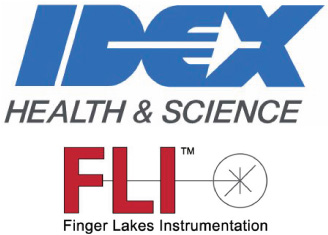
Flat Field Correction

Finger Lakes Instrumentation, a division of IDEX Health & Science LLC
1250 Rochester St.
Lima, New York 14485
1250 Rochester St.
Lima, New York 14485
Phone: 585-624-3760
Email: IHSKeplerSupport@IdexCorp.com
Web: www.flicamera.com
Email: IHSKeplerSupport@IdexCorp.com
Web: www.flicamera.com
©2023 IDEX Health & Science LLC
A flat field image is an image of uniform brightness, meaning there is no objects, and no brightness difference across the frame. A flat field image can be taken of a well lit wall, or, for a more accurate flat, of the sky with no clouds at a time where there is no gradient across the frame. The goal of a flat field image is to determine how high or low each pixel is compared to the mean pixel value.
Flat field correction (FFC) is a process where irregularities in pixel values are corrected by multiplying each pixel value by a factor that uniformizes the brightness across the image. FFC can correct for very small irregularities caused by dust or damage on a lens, however it is best used to correct vignette caused by a lens.
An image with no flat field correction applied is displayed as Figure 1. The final result of the correction is displayed as Figure 2. Most notably, one can clearly see how the edges are brighter than the center in Figure 1, and in Figure 2, the image brightness is uniform.
Within FLI Pilot, there are two ways to apply FFC: manually and automatically. One may manually apply flat field correction with the Flat Field Correction menu of Tester Routines. One may have a flat field correction applied automatically after each image taken with the Post Process menu.
The images used to make a flat field correction are called master flat frames. These master flat frames are stacked images of a flat field with Fixed Pattern Noise Correction applied. Flat field correcting requires the settings and configurations used for taking a master flat frame to be the same settings and configurations for the image intended to be corrected. Thus, users will likely have many master flat frames for the various settings they intend to use. FLI recommends the development of a master flat frame library to store many master flat frames in one location.
For precision imaging, it is not recommended to expect a master flat frame library to maintain precision over time or between hardware changes such as lens swapping or focal changes. This is due to the likelihood that small changes, such as dust, imperfections, and scratches will move relative to the sensor, regardless of how careful the user may be. For general imaging, this may not cause problems, however it is still not recommended. Additionally, when using filter wheel devices, a set of master flat frames need to be generated for each filter, as each will alter the incoming light in a different way.
Figure 1: Uncorrected Image
Figure 2: Flat Field Corrected Image
